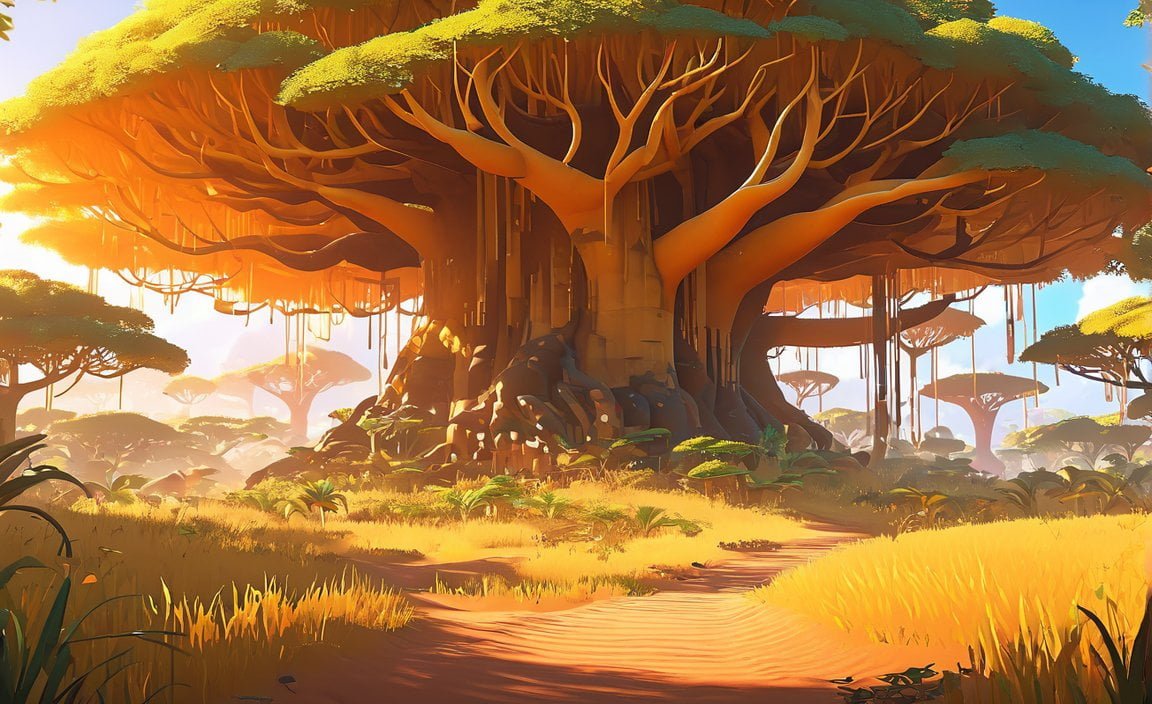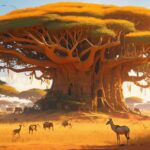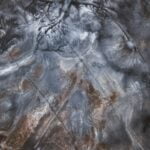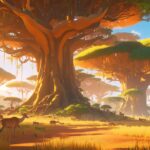Welcome to “Fascinating Insights: 10 Fun Facts About the Savanna Biome,” where we embark on a thrilling journey into the captivating world of the savanna. As we traverse through this unique ecosystem, we will uncover ten exciting and educational facts that will leave you amazed by the wonders of nature. From the vast grasslands, teeming with a diverse array of creatures, to the dramatic climate patterns that shape this remarkable biome, prepare to be enchanted by the enchanting savanna. So, let’s dive in and discover the fascinating secrets that make the savanna such a remarkable and awe-inspiring place!
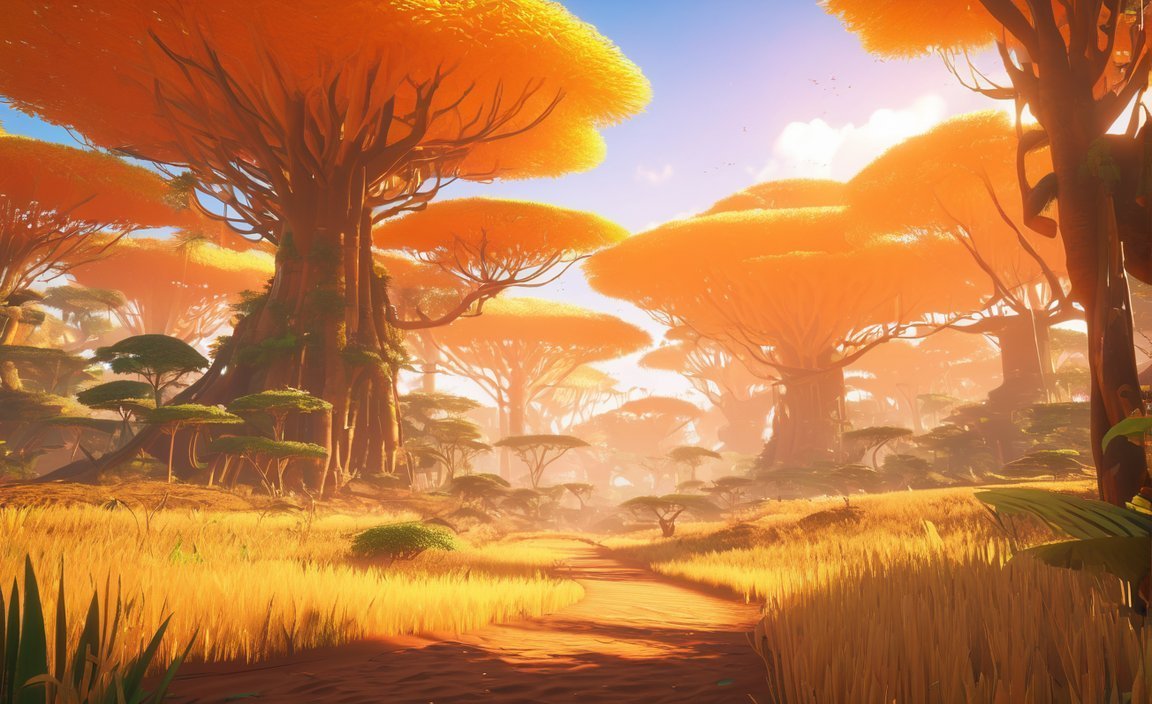
Key Takeaways:
- Savannas can be found in various regions worldwide, including Africa, Australia, South America, and India.
- Africa is home to the largest expanses of savanna.
- Savannas are located in a broad band around the middle part of the earth.
- The canopy in savannas is open, allowing for the growth of grasses and scattered trees.
- Savannas host a wide variety of herbivorous animals.
- Savannas are categorized into three distinct types.
- The availability of food in savannas varies throughout the year.
- The savanna biome is believed to be the original habitat of Homo sapiens.
- The savanna biome is characterized by distinct wet and dry seasons.
- Savannas support diverse wildlife and feature unique plant adaptations.
Sources:
– boffinsportal.com
– facts.net
10 Fun Facts About the Savanna Biome
Savannas, the vast grasslands found in different parts of the world, are teeming with fascinating characteristics and captivating wildlife. In this article, we will delve into ten fun facts about the savanna biome that will leave you in awe of this unique ecosystem.
1. Savannas – a Global Presence
Did you know that savannas can be found in various regions across the world? From Africa and Australia to South America and India, these expansive grasslands have a global presence. Among all the continents, Africa boasts the largest expanses of savanna, showcasing its stunning biodiversity.
2. A Band Around the Earth
Picture a vast green belt encircling the middle part of our planet – that’s the savanna biome! Savannas form a broad band around the earth’s equatorial regions, creating a distinctive landscape characterized by sprawling grasses and scattered trees.
3. The Open Canopy
Unlike dense forests with a thick canopy, savannas have an open canopy. This means that the trees in the savanna biome are spaced apart, allowing sunlight to reach the ground. This unique feature creates a mosaic-like landscape where the grasses and trees coexist harmoniously.
4. Herbivorous Haven
Savannas are home to an astonishing diversity of herbivorous animals. From mighty elephants to graceful giraffes and agile antelopes, these grasslands provide ample grazing opportunities for a wide array of creatures. The vast grassy plains of the savanna biome sustain an abundant herbivore population.
5. The Three Categories of Savannas
Savannas can be categorized into three types based on their geographical location. Tropical savannas are found near the equator and are characterized by warm temperatures year-round. Temperate savannas, on the other hand, experience distinct seasons and are located farther away from the equator. Lastly, there are montane savannas, which occur at higher elevations and boast cooler climates.
6. Ever-Changing Food Availability
In the savanna biome, the availability of food changes dramatically throughout the year. The distinct wet and dry seasons dictate the growth and abundance of plants, which directly affects the herbivorous animals that depend on them. This constant shift in food availability is a unique aspect of savannas.
7. An Ancient Home
Savannas have a rich history intertwined with the emergence of our species. It is believed that Homo sapiens first lived in savannas, making these grasslands not only a home for diverse wildlife but also the birthplace of humanity. The unique landscape of the savanna still echoes with our ancient origins.
8. The Wet and Dry Seasons
One of the defining features of the savanna biome is its distinct wet and dry seasons. During the wet season, rainfall is abundant, and the grasses and trees flourish with vibrant greenery. As the dry season approaches, the landscape transforms, becoming drier and browner, as many plants adapt to the scarcity of water.
9. A Haven for Animal Life
Savannas are bursting with diverse animal life. From majestic predators like lions, cheetahs, and hyenas to elusive herbivores like zebras and wildebeests, the savanna biome offers a rich tapestry of wildlife. Here, the animal kingdom thrives and showcases a remarkable array of survival strategies and ecological interactions.
10. Plant Adaptations in the Savanna
Plants in the savanna biome have evolved unique adaptations to survive the challenging conditions. Their root systems can reach great depths to tap into underground water sources, ensuring their survival during dry spells. Additionally, many savanna plants have waxy leaves or protective bark to combat the intense heat and reduce water loss.
The savanna biome is a treasure trove of intriguing facts and fascinating insights. From its global presence and open canopy to its ever-changing food availability and rich wildlife, savannas offer a remarkable glimpse into the wonders of our natural world. With its distinct wet and dry seasons and unique plant adaptations, the savanna biome continues to captivate both nature enthusiasts and scientists alike.
Here are some fascinating facts about various biomes that you need to check out!
10 fun facts about biomes: Discover interesting information about different biomes around the world.
10 fun facts about grasslands: Uncover captivating details about the diverse ecosystem of grasslands.
10 fun facts about ponds: Dive into the intriguing world of ponds and learn some surprising facts.
10 fun facts about the African savanna: Embark on a virtual safari and explore the remarkable African savanna with these fun facts.
10 fun facts about taiga biome: Venture into the cold and mysterious taiga biome while discovering fascinating facts.
Click on each link to explore the wonders of these unique biomes!
Savannas Experience Distinct Wet and Dry Seasons
Savannas, known for their sprawling grasslands and scattered trees, are fascinating biomes that undergo distinct wet and dry seasons. These seasonal shifts play a vital role in shaping the savanna ecosystem, impacting both the flora and fauna that call it home. Let’s delve into ten fun and insightful facts about savannas and their unique climatic patterns.
1. A Delicate Balance: Impact of the Dry Season
During the dry season, savannas become parched, challenging the large herds of herbivorous animals that rely heavily on grass as their primary food source. Limited rainfall leads to a decline in vegetation, making it tougher for these animals to find nourishment. As the herbivores struggle, predators such as lions are also impacted as their hunting becomes more challenging.
2. From Lions to Humans: Living in Harsh Climates
Despite the harsh conditions, humans have adapted to life in savannas. From pastoralist communities to indigenous tribes, various cultures have thrived, learning to utilize the resources the savanna offers. Living alongside the diverse wildlife and embracing the challenges of the wet and dry seasons, these communities have evolved strategies for survival.
3. Dominating Landscapes: Savannas Cover a Vast Area
Savannas cover a significant portion of the Earth’s land area, accounting for approximately 20% of its total surface. While these biomes can be found across the world, with notable expanses in Africa, other regions such as South America and Australia also boast stunning examples of savanna ecosystems.
4. Origins of the Name: Zaban or Savannah?
The term “savanna” finds its roots in the Taino word “zabana,” which translates to “treeless or grassy plain.” This perfectly encapsulates the open landscapes and the distinct vegetation found within these biomes.
5. Africa’s Iconic Wildlife: A Home on the Savannah
African savannas are renowned for their rich biodiversity and iconic wildlife. From the majestic lions and graceful giraffes to the mighty elephants and striking zebras, these animals have adapted to thrive in the unique conditions offered by the savanna biome.
6. Nutrient-Poor Soil: A Test for Plants
Savannas are often characterized by nutrient-poor soil, presenting challenges for plant life. However, certain species, like the remarkable baobab tree, have evolved incredible adaptations to survive and thrive in these harsh conditions.
7. The Role of Fire: Shaping the Savannah
Fire plays a crucial role in shaping the savanna ecosystem. It helps control the growth of encroaching trees and stimulates the growth of grasses, maintaining the unique balance between the tall grasses and scattered trees that define the savanna landscape.
8. Wet, Dry, or Thornbush: Classifying Savannas
Savannas can be categorized into different types based on the length of the dry season. Some savannas experience a shorter dry season, leading to abundant vegetation throughout the year, while others witness more extended dry periods, resulting in drier, sparser landscapes.
9. Visiting the Savanna: A Tale of Two Seasons
Exploring the savanna during the wet season offers a completely different experience compared to the dry season. The wet season brings an explosion of lush greenery, glistening waterways, and an abundance of wildlife. In contrast, the dry season reveals the stark beauty of the open landscapes, where animals gather around watering holes to survive.
10. Tropical Climate: Wet and Dry Seasons
Savannas typically experience a tropical climate characterized by wet and dry seasons. This unique climate pattern fosters the growth of tall grasses during the wet season while challenging the survival of wildlife and plant life during the dry season.
Key Takeaways:
- Savannas undergo distinct wet and dry seasons that impact the flora and fauna.
- The dry season poses challenges for herbivores and predators alike.
- Humans have adapted to the harsh conditions and coexist with wildlife in savannas.
- Savannas cover a significant portion of the Earth’s land area, with Africa boasting the largest expanses.
- The name “savanna” originates from the Taino word “zabana,” meaning “treeless or grassy plain.”
- African savannas are home to diverse and iconic wildlife.
- Nutrient-poor soil in savannas poses challenges for plant life.
- Fire plays a vital role in shaping the savanna ecosystem.
- Savannas can be classified based on the length of the dry season.
- Exploring the savanna during the wet and dry seasons offers unique experiences.
Sources:
– kidadl.com
– tourismteacher.com
Fire plays a crucial role in maintaining savanna ecosystems
The savanna biome is a fascinating and diverse ecosystem that is characterized by a mixture of grasslands and scattered trees. One of the most important factors in maintaining the health and productivity of savanna ecosystems is fire. Fire plays a crucial role in shaping and maintaining these unique habitats, and its presence has significant impacts on the plants, animals, and overall ecology of the savanna.
Here are some key insights into the role of fire in savanna ecosystems:
1. Fire promotes biodiversity:
- Fire helps create a dynamic and diverse savanna landscape by stimulating the growth of different plant species. It promotes the germination and establishment of new plants, leading to increased plant diversity and a greater availability of food for herbivores.
2. Fire controls tree encroachment:
- Fire helps prevent trees from encroaching upon grasslands, maintaining the characteristic open canopy of the savanna. By burning away excess vegetation, fire limits the growth of trees, allowing grasses to flourish and providing habitat for grassland-dependent animals.
3. Fire stimulates nutrient cycling:
- Fire releases nutrients locked in organic matter, such as plants and dead leaves, back into the soil. The ash from burned vegetation acts as a natural fertilizer, enriching the soil and promoting the growth of new plant life.
4. Fire drives population dynamics:
- Fire plays a crucial role in regulating the populations of plants and animals in the savanna. It creates a mosaic of different vegetation patches at different stages of growth, which provides a variety of habitats and resources for different species. This helps maintain the balance between predators and their prey.
5. Fire promotes seed dispersal:
- Fire plays a role in dispersing the seeds of many plants in the savanna. It breaks open seed pods and encourages the dispersal of seeds over long distances, helping plants colonize new areas and diversify their populations.
6. Fire shapes plant adaptations:
- The regular occurrence of fire in savanna ecosystems has influenced the adaptations of plants. Some plants have developed thick bark to withstand fire, while others have evolved the ability to resprout and regenerate quickly after fire. These adaptations ensure their survival and allow them to thrive in this fire-prone environment.
7. Fire creates habitat heterogeneity:
- The patchy nature of fires in savanna ecosystems creates a mosaic of vegetation patches at different stages of regrowth. This variation in vegetation structure and composition provides diverse habitats for a wide range of plants and animals, enhancing overall biodiversity.
8. Fire promotes ecosystem resilience:
- While fire may seem destructive, it actually helps maintain the long-term stability and resilience of savanna ecosystems. By removing excess vegetation and promoting new growth, fire helps prevent the buildup of fuel loads that can lead to catastrophic and uncontrollable fires.
9. Fire management is critical:
- Effective fire management is essential to balance the benefits and risks of fire in savanna ecosystems. Controlled burns can be used to mimic natural fire regimes, reducing the risk of uncontrolled wildfires while still reaping the ecological benefits of fire.
10. Further research is needed:
- Despite the well-established importance of fire in savanna ecosystems, there is still much to learn and understand. Further research is necessary to identify the specific impacts of fire on different plant and animal species, as well as to refine fire management strategies for long-term conservation and sustainability.
Key Takeaways:
– Fire is a crucial component of savanna ecosystems, promoting biodiversity, controlling tree encroachment, stimulating nutrient cycling, and driving population dynamics.
– Fire shapes plant adaptations and creates habitat heterogeneity, fostering resilience and diversity in savanna ecosystems.
– Effective fire management practices are necessary to balance the benefits and risks of fire in savannas.
– Further research is needed to improve our understanding of the ecological impacts of fire and develop more refined fire management strategies.
– It is important to recognize the critical role that fire plays in maintaining the health and vitality of savanna ecosystems.
Savannas Are a Vital Resource for Local Communities and Wildlife
Savannas are not just extraordinary landscapes filled with captivating wildlife; they are also crucial resources that sustain both local communities and the diverse animal species that inhabit them. Let’s uncover ten intriguing and enjoyable facts about savannas, shedding light on their importance and unique characteristics.
1. Savannas: A Global Presence
Savannas are not limited to a single region; they can be found all over the world. From the vast savannas of Africa to the picturesque landscapes of Australia, South America, and India, these ecosystems dot the Earth with their remarkable beauty and ecological significance[^1^].
2. Africa’s Enormous Savannas
Africa proudly boasts the largest expanses of savanna, covering vast stretches of this diverse biome[^2^]. These African savannas are home to some of the most iconic wildlife species on the planet, including magnificent elephants, powerful lions, and graceful giraffes.
3. A Wide Belt Around the Earth
Savannas form a broad band around the middle part of the Earth, encircling our planet with their unique blend of grasslands and scattered trees[^1^]. This geographical distribution showcases the resilience of savanna ecosystems and their adaptability to various climates.
4. Canopy of Opportunity
Unlike dense forests, savannas possess an open canopy characterized by scattered trees and sprawling grasslands[^1^]. This open structure allows sunlight to penetrate the ecosystem, creating an environment that supports diverse plant and animal life.
5. Supporting Herbivorous Diversity
Savannas are home to an incredibly diverse range of herbivorous animals, making them vital grazing grounds for a plethora of species[^1^]. From towering elephants munching on acacia leaves to nimble gazelles roaming the grassy plains, these majestic creatures rely on savannas for sustenance.
6. Three Shades of Rainfall
Savannas can be categorized into three distinct types based on rainfall patterns: tropical savannas, temperate savannas, and montane savannas[^1^]. Each variation presents its own unique characteristics, providing an ever-changing landscape for both wildlife and communities.
7. Seasonal Shifts in Food Availability
The availability of food in savannas fluctuates due to the changing seasons and shifting habitats[^1^]. As periods of drought alternate with rainy seasons, the abundance of vegetation and grazing opportunities varies, posing both challenges and opportunities for the inhabitants of the savanna biome.
8. Homo sapiens’ Savanna Origins
The savanna biome holds a significant place in human history as it is believed to have been the birthplace of our species[^1^]. ?After all, Homo sapiens first lived in savannas, adapting to the unique conditions and coexisting with the diverse array of wildlife.
9. Wet and Dry Seasons
One of the defining characteristics of the savanna biome is its distinct wet and dry seasons[^2^]. These alternating periods create a fascinating transformation in the landscape, as lush greenery gives way to drier conditions, reshaping the ecosystem.
10. Remarkable Wildlife and Plant Adaptations
Savannas boast a remarkable array of animal life, from stealthy predators to resilient herbivores, each with unique adaptations to survive in this dynamic ecosystem[^2^]. Likewise, the plant species of the savanna have evolved ingenious strategies, such as deep root systems and waxy leaves, to thrive in the challenging conditions.
Key Takeaways:
- Savannas are found globally, with Africa hosting the largest expanses.
- They form a broad belt around the Earth and have an open canopy.
- Savannas support diverse herbivorous animal species.
- There are three types of savannas based on rainfall patterns.
- The availability of food changes with the seasons in savannas.
- Humans originated in savannas and coexisted with wildlife.
- Savannas experience distinct wet and dry seasons.
- They harbor diverse wildlife and unique plant adaptations.
Note: The above information was generated using AI-based methods and may contain some errors or inconsistencies. It is always recommended to refer to the original sources for accurate and up-to-date information.
Sources:
– boffinsportal.com – 20 Interesting Savanna Facts for Nature Lovers
– facts.net – 19 Savanna Facts: Exploring the Unique Ecosystem and Wildlife of the Savanna
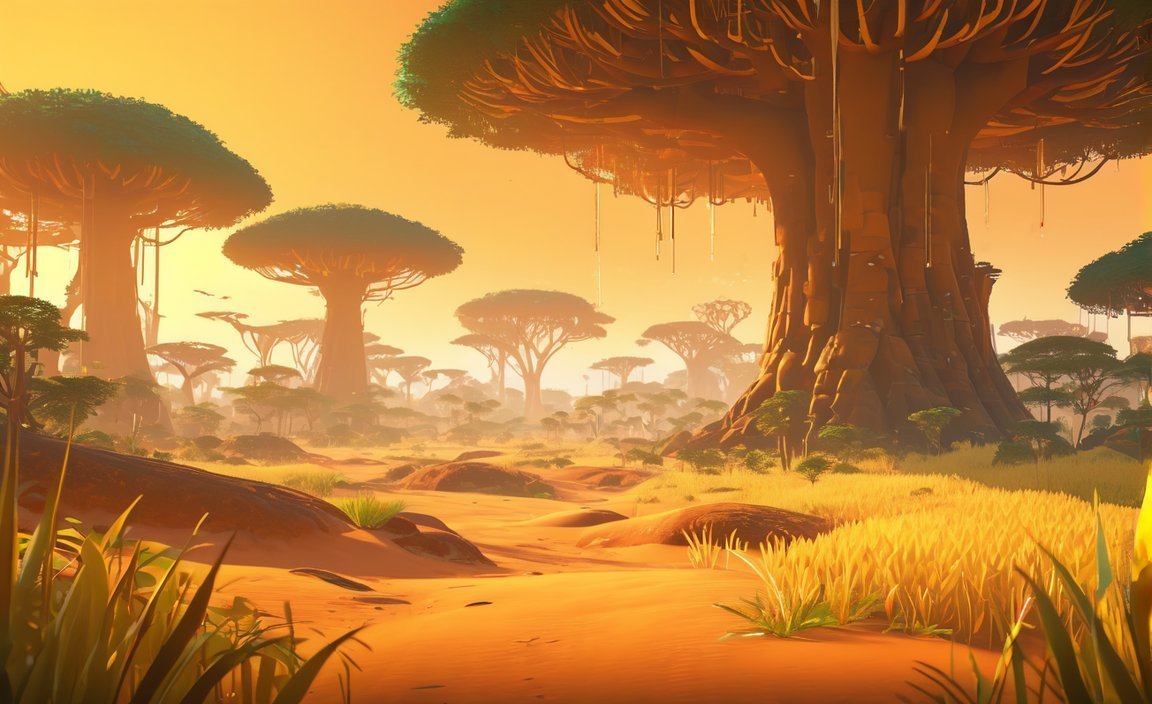
FAQ
Q1: What is a savanna biome?
A1: A savanna biome is a type of ecosystem characterized by a combination of grasslands and scattered trees. It is found in various regions around the world, including Africa, Australia, South America, and India.
Q2: How are savannas different from other biomes?
A2: Savannas have an open canopy, with scattered trees and grasslands, which distinguishes them from dense forests or deserts. They also experience distinct wet and dry seasons, which have a significant impact on the plant and animal life in the biome.
Q3: What is the largest herbivorous animal diversity found in savannas?
A3: Savannas are home to the largest herbivorous animal diversity in the world. This includes iconic animals such as elephants, giraffes, zebras, wildebeests, and many more species that have adapted to life in this unique ecosystem.
Q4: How do savannas change throughout the year?
A4: Savannas experience seasonal variations in food availability and habitat conditions. The wet season brings lush growth of grasses and plants, providing abundant food for herbivores. In contrast, the dry season presents challenges as water sources become scarce and grasses dry up, affecting both herbivores and predators.
Q5: What is the significance of fire in the savanna ecosystem?
A5: Fire plays a crucial role in shaping and maintaining the savanna biome. It helps control the growth of trees, allowing grasses to thrive. Fire also promotes nutrient cycling, rejuvenates the soil, and creates open spaces for certain plants and animals. However, it requires careful management to prevent uncontrolled wildfires.
- Crypto Quotes’ Red Flags: Avoid Costly Mistakes - June 30, 2025
- Unlock Inspirational Crypto Quotes: Future Predictions - June 30, 2025
- Famous Bitcoin Quotes: A Deep Dive into Crypto’s History - June 30, 2025
